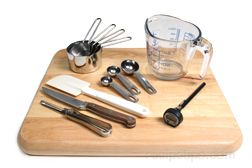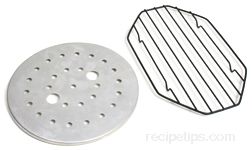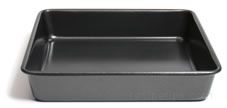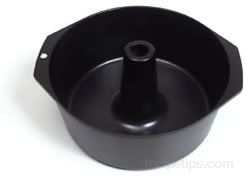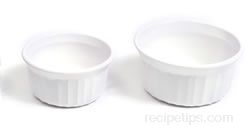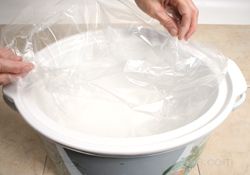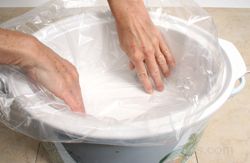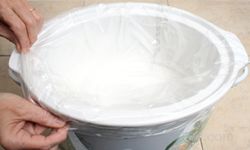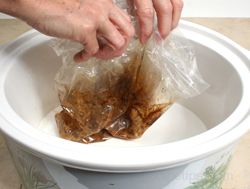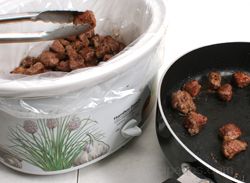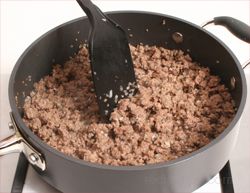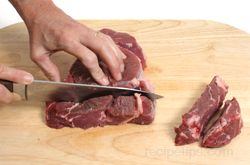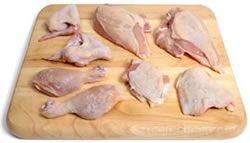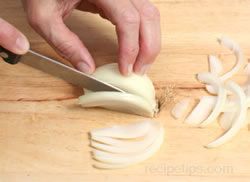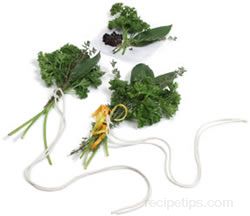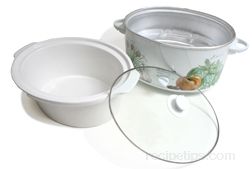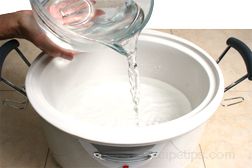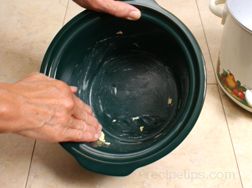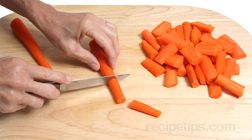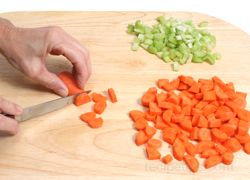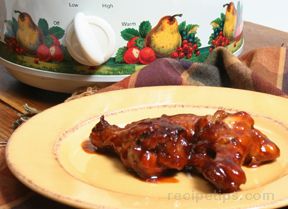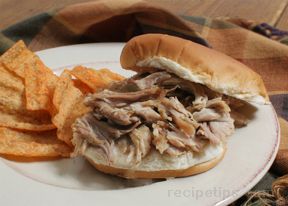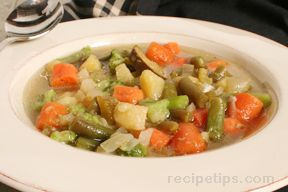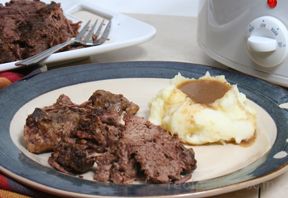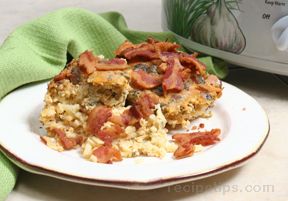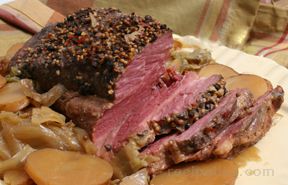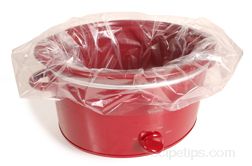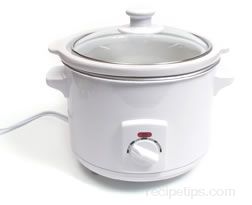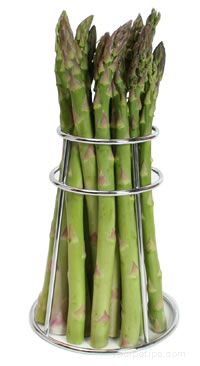|
Some slow cooking recipes will require the use of another pan or some utensils but most often the slow cooker is all you will need for cooking. One very useful item that can be used when preparing food in a slow cooker is a crock liner. Slow cooker crock liners make clean up a breeze. For slow cooking meat recipes,the meat should be fresh or completely thawed. Preparation of fruits and vegetables for slow cooking recipes is generally the same as preparing them for other methods of cooking. There are also many herbs and spices that can be used to add flavor to the food when slow cooking.
| |||||||||||||||||||||||||||||||||||||||||||||||||||||||||||||||||||||||||||||||||||||||||||||||||||||||||||||||||||||||||||||||||||||||||||||||||||||||||||||||||||||||||||||||||||||||||||||||||||||||||||||
| Ingredient Type | Description | |
| Meat |
The tougher, less expensive cuts work best for slow cooking because they contain higher amounts of connective tissue called collagen. When cooked in the moist heat of the slow cooker the collagen melts and results in a very tender cut of meat. The more expensive cuts do not contain the connective tissues found in the less expensive cuts, so they end up falling apart when cooked in a slow cooker.
Types of cuts for slow cooking:
Ground Meat:Ground meat, such as ground beef or ground turkey, should be browned before adding to the slow cooker with other ingredients. | |
| Vegetables |
There are many different slow cooking recipes that call for vegetables, either by themselves or in with other food. Dense vegetables, such as carrots, potatoes, celery, onions, turnips, beets, parsnips, rutabagas, and winter squash take a long time to cook. If being cooked with meat or other less dense ingredients, these vegetables should be placed on the bottom of the slow cooker so they are exposed to the warmest temperatures and the liquid in the crock, which will help them cook more evenly. Tender vegetables, such as tomatoes, peppers, peas, snow peas, mushrooms, summer squash, and greens should be added in the last 15 to 60 minutes of cooking time so that they do not overcook. Timing will depend on the quantity added and the type of vegetable. Vegetables, such as cauliflower, broccoli, cabbage and Brussels sprouts that have a strong flavor should also be added in the last 15 to 60 minutes of cooking time to prevent their flavors from becoming too dominating in the overall flavor of the other food. Most canned and frozen vegetables should be added in the last 15 to 45 minutes of cooking time so that they do not become overcooked. It is best to thaw frozen vegetables before adding them. If added while still frozen, the additional cooking time will need to increase because they will reduce the cooking temperature in the slow cooker. | |
| Fruit | Many types of fruit can be cooked in a slow cooker. The fruit can be stewed, poached or baked on its own in the cooker or they can be added as an ingredient in another dish, such as cobblers, crumbles, puddings, and other desserts. | |
| Pasta |
Pasta should not be added from the start and cooked all day with the other ingredients. If adding pasta to soup, add it approximately 10 to 30 minutes before it will be served. If adding to other dishes, the pasta should be cooked on the stovetop until al dente, drained and then added to the other ingredients just long enough before serving so it is thoroughly warmed. For information on cooking pasta on the stovetop, see RecipeTips.com - Boiling Pasta. | |
| Rice |
Long grain rice is best for slow cooking to produce fluffy rice. When adding raw rice, add equal amounts of water and add to the other ingredients approximately 1 to 1 1/2 hours before the end of the cooking time. If the rice was to cook all day with the other ingredients it would become gummy and sticky in texture. The rice can also be cooked in the conventional manner and then added to the dish just long enough for it to be heated thoroughly with the other ingredients before serving. For information on cooking rice using a conventional method, see RecipeTips.com - Boil/Absorb/Steam - Rice. If using brown rice, keep in mind that it generally takes twice the time to cook as white rice, and wild rice takes even longer. | |
| Dried Beans | Dried beans should generally be at least partially cooked before adding to the other ingredients in the slow cooker. Different varieties of beans have different cooking times so it is best to follow the instructions given in the recipe for that particular type of bean. Keep in mind that dried beans will approximately double in size when fully cooked. Dried beans should be cooked completely before they are added to sweet ingredients, such as brown sugar, honey, molasses or maple syrup, and acidic ingredients, such as tomatoes or vinegar. The sweet and acidic ingredients will cause the beans to harden rather than soften while cooking so they need to be tender before adding the beans to them. | |
| Dairy Products |
Milk will curdle after cooking for a long period of time, so add milk just long enough before serving so that it is heated with the other ingredients. Evaporated skim milk will withstand the longest cooking time without curdling. Milk can be added to baked good recipes that cook for 2 to 3 hours without being a problem. Other dairy products, such as cream, cheese, sour cream, and yogurt, will separate if cooked for several hours. It is best to add them at the end of cooking for just enough time to melt them and heat them thoroughly with the other ingredients, approximately 15 to 30 minutes. If it is necessary for cheese to be added in with the other ingredients before the end of cooking, choose a processed cheese, which will withstand a longer cooking time. | |
| Fish |
Sturdy type fish will cook up better than the more delicate types of fish. Delicate fish will break up and fall apart too easily. Sturdy fish will hold up better but for best results, they should be added in the last 45 to 60 minutes of cooking time. Cook the fish just until done. The meat should flake easily when tested with a fork. Shellfish will become tough when cooked for long periods of time. They should be added in the last 15 to 60 minutes of cooking time, depending on the type of shellfish and the quantity being added. | |
| Herbs and Spices |
Herbs: It is generally thought that fresh herbs are better to use than dried when cooking, but when slow cooking, dried herbs are most often a better choice because they will release their flavor more slowly. Most fresh herbs have a tendency to lose their flavor and color too quickly. Some herbs, such as parsley, cilantro and chives, do not dry well so they should be added as fresh herbs at the end of the cooking time. Some fresh tender herbs that can be added at the end of the cooking time are parsley, cilantro, chives, basil, dill, tarragon, and chervil. There are some more sturdy herbs, such as bay leaves, oregano, thyme, marjoram, sage and rosemary, that can hold up to the long cooking times and can be added a the start of the cooking time. They release mild flavor and then are generally removed from the dish before serving. Spices: Most often spices are add at the beginning of the cooking time but there are some spices that become bitter when cooked too long. Spices, such as chili, pepper, ginger and mustard, add varying levels of heat to the dish. There are many varieties of chili products that can range from mildly sweet to fiery hot but they all turn bitter when cooked for a long period. When using for slow cooking, they should be added more towards the end of the cooking process. Some of the other spices that can be used for slow cooking are: caraway seed, cardamom, cinnamon, cloves, coriander, cumin, juniper berries, nutmeg, poppy seeds, saffron, star anise, and vanilla. |
Ingredient Preparation for Slow Cooking
Meat and Poultry PreparationOnly fresh or completely thawed meat should be used when cooking in a slow cooker. If using frozen meat, be sure it is properly thawed before cooking it in the slow cooker. Some types of meat require preparation before they are added to the slow cooker. See some of the common types of meat preparation shown below. | |||
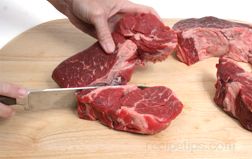 |
| ||
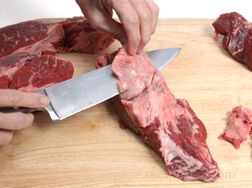 |
Trim off any excess fat. The fat can increase the temperature of the liquid in the slow cooker, causing the meat to overcook. | ||
| |||
 |
| ||
Some types of crocks can be used on the stovetop so the meat can be browned in the crock right on the stovetop. For models that cannot be used on the stovetop, brown the meat in a separate skillet on the stove. | |||
|
Dredge the meat in the flour to lightly coat. Then fry in a non-stick pan that has a light coat of oil or cooking spray. |
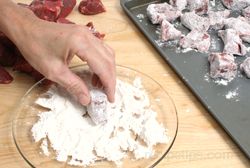 | ||
| If you are not using a non-stick pan, you will have to use more oil. A combination of oil and butter can also be used.
Once the oil/butter is hot, cook the meat until it is nicely browned on all sides. Do not overcrowd the meat when browning. Overcrowding causes the meat to stew rather than brown. |
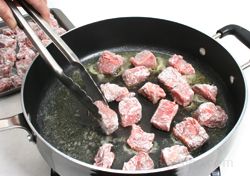 | ||
| When properly browned, remove meat from the pan and add it to the crock. |
| ||
|
The browning process does not have to be done when slow cooking but it will enhance the overall appearance and flavor of the food being prepared in the slow cooker. This same browning process can be used for cubed meat or larger chunks. | |||
|
|
Ground meat must be browned before it is used in slow cooking. Brown ground meat in a frying pan over medium high heat. For extra lean ground meat, such as ground turkey or ground chicken, add a little oil to prevent the meat from sticking. | ||
 |
Cook meat until it is nicely browned. Remove from the heat and drain any fat before adding the meat to the slow cooker. | ||
|
Some meats are cut into cubes and then floured and browned before being added to the other ingredients. Before cutting the meat into cubes, remove as much excess fat as possible. Also remove any other parts that are unwanted, such as gristle. Some of the fat and gristle may have to be trimmed away as you are cutting the meat into cubes. |
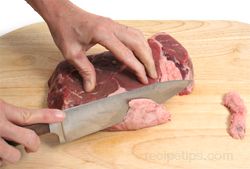 | ||
|
Cut the meat into 1 inch strips. Be sure to cut the meat across the grain, creating shorter fibers, which will result in more tender meat. |
| ||
| Cut the strips of meat into 1 inch pieces to form cubes. If the meat is an odd shape that makes it hard to cut it into cubes, just cut into even size pieces. |
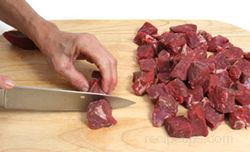 | ||
| If some strips are extra thick, they may have to be cut in half lengthwise before cutting the cubed pieces.
After cutting the cubes, they should be browned in the same manner as shown above. |
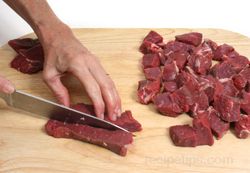 | ||
|
|
If using a whole chicken, be sure to cut it up into pieces before cooking in the slow cooker. For instructions on cutting up a whole chicken, see RecipeTips.com - Cutting Up Chicken. | ||
 |
Remove all the skin from the chicken before placing in the slow cooker. This will reduce the amount of fat. Pull the skin away from the meat. The chicken will be slippery, so to get a firm hold, use a paper towel when gripping the piece and pull the skin off with the other hand. Use a small knife to help cut the skin away if necessary. The bones can be cut out of the pieces but leaving the bone in will add flavor to the meat. | ||
|
Once the meat is properly browned, add it to the slow cooker to finish cooking. | |||
Vegetable PreparationPreparation of vegetables for slow cooking is generally the same as preparing them for other methods of cooking. They are most often cut into a smaller size to help ensure that they cook thoroughly. See the information below for preparing some of the commonly used vegetables for slow cooking. | ||
|
Dense Vegetables Before preparation starts, all the vegetables should be cleaned properly. Rinse under cold water and use a vegetable brush to clean them if necessary. | ||
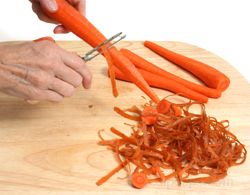 |
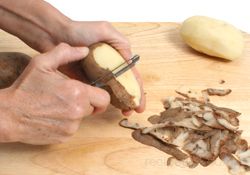 | |
Peel any vegetables, such as carrots, potatoes, sweet potatoes, parsnips, and turnips that require the skin be removed. Trim the ends and cut out any blemishes the vegetables may contain. | ||
 |
| |
Vegetables, such as carrots, potatoes, sweet potatoes, parsnips, and turnips, should be cut into small consistent size pieces to allow them to cook evenly and thoroughly. Cut into 1/4 inch slices or bite size pieces. | ||
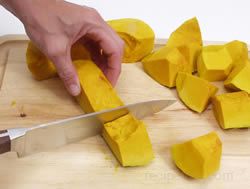 |
Winter squash has dense, fibrous flesh that should be cut into small pieces to ensure proper cooking. Squash will also produce a lot of liquid as it cooks so the amount of liquid add to the slow cooker should be reduced when cooking squash. For more squash preparation information, see RecipeTips.com - All About Winter Squash. | |
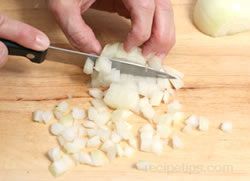 |
| |
Onions are slow to cook in a slow cooker. It is best to cut them into small pieces or thin slices so they will be properly cooked when the other ingredients are done. For more onion preparation information, see RecipeTips.com - All About Onions. | ||
 |
Onions also benefit from browning before adding to the slow cooker. Add some butter or cooking oil to a pan and cook the onions over medium-high heat. The browned onions will add color and flavor to the dish and will get a head start on cooking. | |
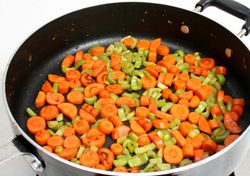 |
Other vegetables can also be browned, for added color and flavor, before adding them to the slow cooker. | |
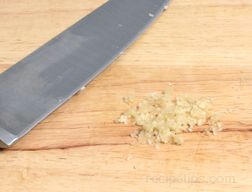 |
Garlic loses some of its strength after cooking for long periods so you may want to add a little more when slow cooking. Crushed or chopped garlic will produce more flavor than whole or sliced garlic. For more garlic preparation information, see RecipeTips.com - All About Garlic. | |
|
Vegetables, such as tomatoes, peppers, peas, snow peas, mushrooms, summer squash, and greens are more delicate and do not require as much cooking so many times they are added towards the end of the cooking time. | ||
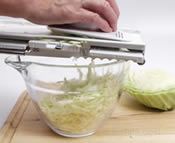 |
 | |
|
Peas and snow peas should be cleaned and then added to the slow cooker during the last 15 to 45 minutes of cooking time. For more information on cleaning and preparing peas, see RecipeTips.com - All About Peas. | ||
|
Tomatoes add a lot of flavor and moisture to the dish when slow cooked. The tomatoes can provide some cooking liquid for the other ingredients so it is best to add them at the beginning of the cooking process. The skins can become tough when cooked for long periods so it is best to remove them before adding the tomatoes to the dish. |
 | |
| The seeds can turn bitter when cooked for long periods so they should also be removed before adding the tomatoes. To remove the seeds, cut the tomato in half and scoop the seeds out with a spoon.
For instructions on how to remove the skin and more tomato preparation information, see RecipeTips.com - All About Tomatoes. |
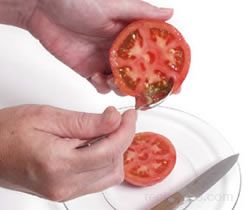 | |
|
Mushrooms should be carefully cleaned and left whole or sliced before adding to the crock pot. For information on how to clean mushrooms, see RecipeTips.com - All About Mushrooms. | ||
|
| ||
 |
Cut large Brussels sprouts in half before adding to the crock. | |
 |
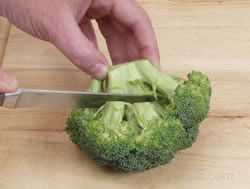 | |
Cauliflower and broccoli should be cut into small pieces so that they cook evenly. | ||
|
Note: Be sure to follow the instructions given in the recipe to ensure proper preparation of the vegetables for the dish being prepared. Preparation of the vegetables will depend on other ingredients and the cooking time for the entire dish. | ||
Fruit PreparationPreparation of fruit for slow cooking recipes, like the preparation of vegetables, is generally the same as preparing them for other methods of cooking. They are most often peeled, sliced or cored. See the information below for preparing some of the commonly used fruits for slow cooking. | ||
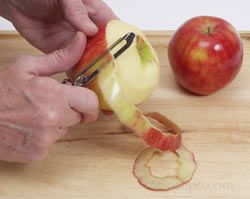 |
Apples and pears can have their skins removed by peeling them with a vegetable peeler or a small knife. | |
 |
Peel peaches by placing in a heat safe bowl and pouring boiling water over them to cover. Leave them in the boiling water for 30 seconds. Remove with a slotted spoon and submerge into cold water. | |
 |
Remove peaches from the cold water and using a small pairing knife, pull skin off. Begin with pairing knife at the top of the peach and pull downward. Alternative: Another method to try for loosening the peel is to microwave the peach at full power for 15 seconds and then allow it to stand for 2 minutes before peeling. | |
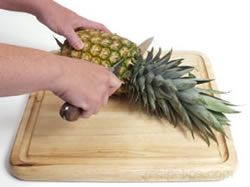 |
Some fruit, such as pineapple, will need to have its rind cut away. Remove the plume from the pineapple by cutting it at the crown with a sharp knife. | |
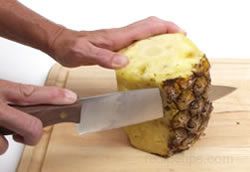 |
Trim a slice off the bottom and set the pineapple up on end. Trim the rind by making vertical cuts around the outside of the pineapple until all of the rind has been trimmed away. Make sure to cut thick enough slices so that the eyes are removed when trimming the rind. | |
|
Removing Cores or Stones
|
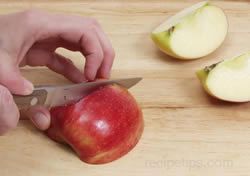 | |
| Using a sharp knife, cut at an angle starting at one end and cut to the middle of the section. | 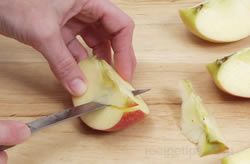 | |
| Repeat starting at the opposite end cut to the middle, meeting the first cut. Remove the core and cut the core from the other quarters. |  | |
| Removing the Stone from a Peach: Cut around the perimeter (follow the natural indentation) down to the pit using a small knife. Begin the cut at the stem of the peach. Make a slice around the entire perimeter of the peach. |  | |
| Twist the peach halves in opposite direction until they separate from each other. |
| |
| The pit will remain in one half of the peach when they are separated. Remove the pit using a knife or your fingers to pry it loose from the center of the peach. | 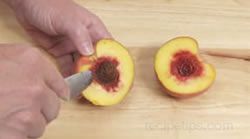 | |
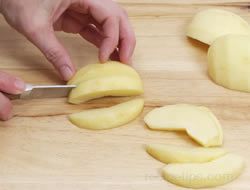 |
Many different types of fruit may require slicing into smaller pieces, depending on the recipe. Apples:Use a sharp knife to cut quartered and cored apples by placing the apple core side down and cutting into 1/8 to 1/4 inch slices. Thickness will depend on end use. If you want the apples to hold their shape, cut at least 1/4 inch thick. | |
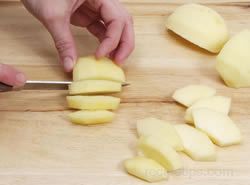 |
Cut across the quarters when preparing the apples for slow cooking recipes with shorter cooking times. This will create a shorter slice that will cook faster. | |
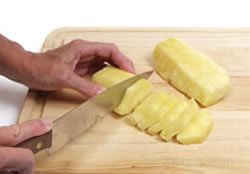 |
Pineapple: Pineapple can be cut in several different manners. To cut wedges, cut the pineapple in half lengthwise after removing the rind and then cut lengthwise into quarters. Slice the core off from the inside edge and then slice crosswise to create wedges to desired thickness. | |
 |
To create pineapple chunks, cut quartered sections lengthwise into thinner spears and slice off core from each spear. | |
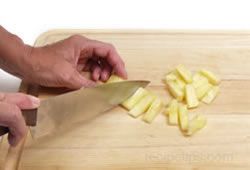 |
Cut spears crosswise into approximately 1/2 inch thick chunks. | |
|
Note:Be sure to follow the instructions given in the recipe to ensure proper preparation of the fruit for the slow cooking dish being prepared. Preparation of the fruit will depend on other ingredients and the cooking time for the entire dish. | ||
Flavoring PreparationThere are many herbs and spices that can be used when slow cooking. They can be added to the dish on their own or they can be added in a bouquet garni. This technique is a good method to use to add flavoring without having to include the herbs or spices themselves when serving the dish.
A bouquet garni may be made from either fresh ingredients tied together or dried ingredients mixed and placed in cheesecloth tied into a bag for dipping into soups, stews, sauces, casseroles, or meat dishes. For information on how to make a bouquet garni, see RecipeTips.com - Bouquet Garni. |

